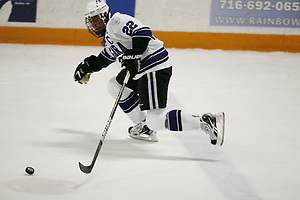It’s relatively easy to pick a player of the year, a goalie, a rookie, all that stuff, but I’m going to try throwing a few new categories in there as well, to give some credit to those who deserve it… but in very specific ways.
Props for the Players
Pad-pounder award: Alex Killorn, Harvard
The Crimson junior averaged over four and a half shots per game, leading the league in that category and keeping every goaltender on his toes… or knees, or side, or whatever he had to do to stop the rubber. Generating shots is obviously a great way to generate goals (and Killorn had 13 of them on what was a generally impotent offense), but it also means that the other team isn’t taking those shots: Killorn finished a team-best +4 for the campaign, thanks as much to his ability to keep the puck as his ability to let it fly.
Most inconspicuously lethal award: Mat Bodie, Union
That’s a pretty broad category, of course, but Bodie fits it to a T. He plays for a regular-season league champion that boasts only one scorer among the ECAC’s top 20. He’s a defenseman who puts up points, but not many goals. He isn’t a seasoned veteran with a proven track record; not only is he an exceptional rookie with a team full of exceptional rookies (Daniel Carr, Josh Jooris, and Matt Hatch), but he’s not even the highest-ranking Bodie on the team – brother Kyle is a sophomore. But if he has to be second-best in almost any quantifiable category, he may as well be the best second-best player in the league. With 14 league points and 28 overall, Bodie is no tagalong… and with the second-best +/- in the league (+17, after his captain, Brock Matheson’s +19), Bodie is no cherry-picking coaster, either.
Rookie of the year: wait for it… who will it be…?…
… Greg Carey, St. Lawrence
Yes, the aforementioned Carr and Princeton’s Andrew Calof were both strong contenders as well, but when it ultimately came down to Calof or Carey, I went to the bottom line: Carey’s 11 league goals accounted for over a fifth of SLU’s conference total, while Calof’s seven goals were only around 10 percent of Princeton’s sum. Calof had more points and a far better +/- rating in league play (+9, to Carey’s -7), but Carey also did a lot of damage on the Saints’ 20-percent power play unit. The long and short of it is that Carey is a primary concern for SLU’s opponents, while Calof is a supporter to the likes of Mike Kramer, Kevin Lohry and Taylor Fedun. Even classmate Andrew Ammon has more goals overall (10) than Calof.
Finishing touch award: Chase Polacek, Rensselaer
The senior who needs no introduction puts up the flashy numbers, of course, but he’s more than a garbage-time cleanup man or a power-play opportunist: Polacek’s a killer. The once-and-ought-to-be-future Hobey candidate led the league with five game-winning goals against conference foes, and eight overall for the ‘Tute, including any icy-veined penalty-shot OT snipe against Colgate.
Bang for the buck award: Ben Sexton, Clarkson
The hard-luck rookie played only 10 games this season after breaking his leg early in early November. He averaged a solid 1.00 shots per game – that would be 10 shots in 10 games – but scored goals on four of them, and finished the regular season with six points. We knew he was a dangerous guy from the get-go, and he did not disappoint… we can only imagine how ‘Tech might have fared with him in the lineup more regularly.
Defenseman of the year: Danny Biega, Harvard
There were others in the mix – Nick Bailen at RPI, Union captain Brock Matheson, and Princeton’s Taylor Fedun, specifically – but sophomore Biega’s combination of points (a league-leading 21 with nine goals) and +/- (+3 on a woefully low-scoring team) kept me from having to resort to a coin-flip. Danny (not to be confused with any of the 18 or so other Biegas running around Bright Hockey Center) led Harvard in both league and overall scoring with 21 and 25 points, respectively, and finished second to Killorn in goals. He potted nearly a fifth of the Crimson’s league goals this season and accounted for over 15 percent of the roster’s points.
Loose cannon award: Harry Zolnierczyk, Brown
Program-record 126 penalty minutes, but also 16 goals and 31 points in 28 games. Need I say more?
Goalie of the year: James Mello, Dartmouth
I can hear Union and Yale fans shrieking already, but hear me out: Mello may have played a shorter, Ivy League schedule, but he was a work horse all the same up in Hanover: Only Clarkson’s Paul Karpowich saw more rubber in ECAC games than Dartmouth’s junior. Despite that, he maintained a high level of play with the best overall (.938) and league (.929) save percentages in ECAC Hockey, and trailed only Union’s Keith Kinkaid (1.90) with a 1.93 goals-against average in conference competition. Thanks to Mello, the Big Green finished with the third-fewest goals against in ECAC Hockey action and the third-highest scoring differential to match.
And finally…
Player of the year: It’s down to Polacek, Union’s Carr, or Yale’s Andrew Miller or Brian O’Neill. Who do you think should earn the accolade? Speak now, click here!
